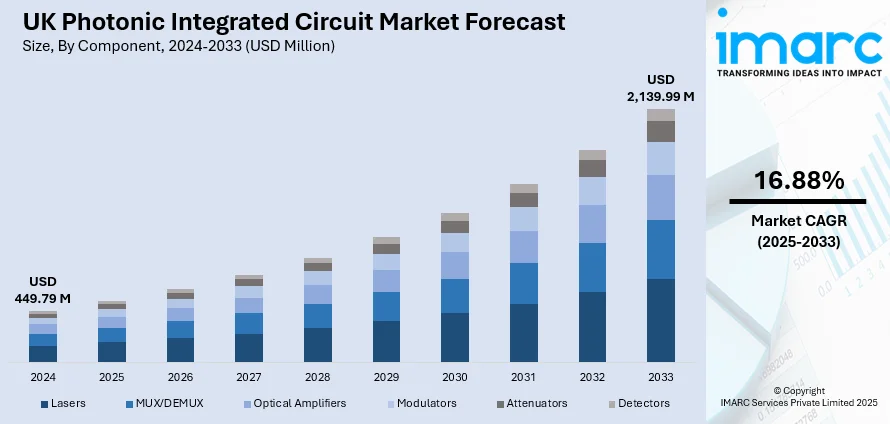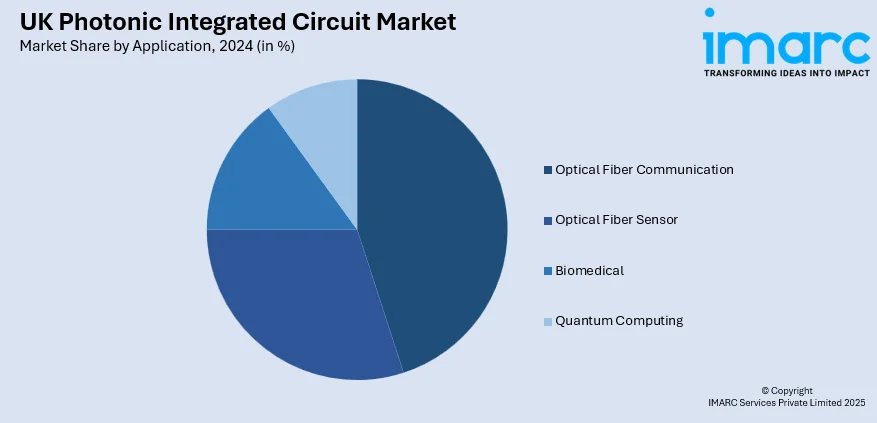
UK Photonic Integrated Circuit Market Size, Share, Trends and Forecast by Component, Raw Material, Integration, Application, and Region, 2025-2033
UK Photonic Integrated Circuit Market Overview:
The UK photonic integrated circuit market size reached USD 449.79 Million in 2024. Looking forward, IMARC Group expects the market to reach USD 2,139.99 Million by 2033, exhibiting a growth rate (CAGR) of 16.88% during 2025-2033. The market is fueled by substantial government investment in photonics research, growing demand from telecom and healthcare sectors, and a vibrant innovation ecosystem. Focus on developing quantum technologies and smart sensors also elevate the UK photonic integrated circuit market share.
|
Report Attribute
|
Key Statistics
|
|---|---|
|
Base Year
|
2024
|
|
Forecast Years
|
2025-2033
|
|
Historical Years
|
2019-2024
|
| Market Size in 2024 | USD 449.79 Million |
| Market Forecast in 2033 | USD 2,139.99 Million |
| Market Growth Rate 2025-2033 | 16.88% |
UK Photonic Integrated Circuit Market Trends:
Government Support for Photonics and Quantum Technologies
The UK government actively supports photonics through funding initiatives such as the UK National Quantum Technologies Programme. Investments focus on advancing PICs for quantum computing, sensing, and secure communications. This strategic emphasis encourages collaboration between academia, startups, and established firms, accelerating commercialization. The government’s commitment to photonics innovation enhances infrastructure and talent development, driving the UK photonic integrated circuit market growth by positioning the country as a leader in next-generation photonic technologies. For instance, in July 2024, Wave Photonics, in collaboration with SENKO Advanced Components and Alter Technology, launched the QPICPAC packaging solution for Quantum Photonic Integrated Circuits (QPICs). Designed for prototyping and R&D, the solution includes verified templates and components that reduce custom development and costs. Supported by Innovate UK, this turnkey service aims to accelerate innovation in quantum technologies through streamlined processes and UK-based end-to-end production, including design kits and scalable, reliable packaging—bringing standardization and efficiency to complex photonic circuit realization.

To get more information on this market, Request Sample
Telecom Network Modernization and 5G Deployment
The UK’s telecom sector is undergoing modernization with widespread 5G infrastructure deployment, driving demand for advanced PIC solutions. Photonic integrated circuits facilitate higher data rates and energy efficiency in network hardware. Major telecom operators and equipment manufacturers invest in integrating PICs into their systems to meet growing bandwidth needs. This infrastructure upgrade accelerates technology adoption and supports sustained market demand. Such developments are instrumental in fostering the UK photonic integrated circuit market growth by enhancing network performance and service quality. For instance, in April 2025, Aixtron SE delivered its G10-AsP MOCVD system to Nokia, enabling the production of 6-inch indium phosphide (InP) wafers for next-generation photonic integrated circuits (PICs). This follows Nokia’s recent $2.3 Billion acquisition of InP specialist Infinera. The G10-AsP offers enhanced on-wafer uniformity, advanced temperature control, and automated wafer handling, improving efficiency and consistency. Nokia sees the tool as a strategic investment to meet growing demand for high-performance PICs and strengthen its position in the photonics industry.
UK Photonic Integrated Circuit Market Segmentation:
IMARC Group provides an analysis of the key trends in each segment of the market, along with forecasts at the country and regional levels for 2025-2033. Our report has categorized the market based on component, raw material, integration, and application.
Component Insights:
- Lasers
- MUX/DEMUX
- Optical Amplifiers
- Modulators
- Attenuators
- Detectors
The report has provided a detailed breakup and analysis of the market based on the component. This includes lasers, MUX/DEMUX, optical amplifiers, modulators, attenuators, and detectors.
Raw Material Insights:
- Indium Phosphide (InP)
- Gallium Arsenide (GaAs)
- Lithium Niobate (LiNbO3)
- Silicon
- Silica-on-Silicon
A detailed breakup and analysis of the market based on the raw material have also been provided in the report. This includes indium phosphide (InP), gallium arsenide (GaAs), lithium niobate (LiNbO3), silicon, and silica-on-silicon.
Integration Insights:
- Monolithic Integration
- Hybrid Integration
- Module Integration
The report has provided a detailed breakup and analysis of the market based on the integration. This includes monolithic integration, hybrid integration, and module integration.
Application Insights:

- Optical Fiber Communication
- Optical Fiber Sensor
- Biomedical
- Quantum Computing
A detailed breakup and analysis of the market based on the application have also been provided in the report. This includes optical fiber communication, optical fiber sensor, biomedical, and quantum computing.
Regional Insights:
- London
- South East
- North West
- East of England
- South West
- Scotland
- West Midlands
- Yorkshire and The Humber
- East Midlands
- Others
The report has also provided a comprehensive analysis of all the major regional markets, which include London, South East, North West, East of England, South West, Scotland, West Midlands, Yorkshire and The Humber, East Midlands, and others.
Competitive Landscape:
The market research report has also provided a comprehensive analysis of the competitive landscape. Competitive analysis such as market structure, key player positioning, top winning strategies, competitive dashboard, and company evaluation quadrant has been covered in the report. Also, detailed profiles of all major companies have been provided.
UK Photonic Integrated Circuit Market News:
- In April 2025, Coherent Corp. launched the 2x400G-FR4 Lite, a silicon photonics transceiver designed for AI-driven data centers and high-speed Ethernet networks. This module supports 500-meter reach, reduces power consumption, and offers a more fiber-efficient alternative to traditional EML-based solutions. Built with integrated silicon photonics components, it eliminates the need for thermoelectric coolers. Complementing Coherent’s 800G-DR8 product, the new transceiver is optimized for high-volume deployments.
- In March 2025, PhotonDelta and Silicon Catalyst formed a strategic partnership to support early-stage photonic startups globally. Combining PhotonDelta’s $1.5 Billion-backed ecosystem with Silicon Catalyst’s 500+ partner incubator, the collaboration offers startups access to funding, technical expertise, and go-to-market support. This alliance aims to accelerate photonic chip innovation for applications in data centers, quantum computing, and sensing. The initiative addresses energy efficiency and scalability, positioning photonic chips as a key solution to surpass Moore’s Law and meet future data and sustainability demands.
UK Photonic Integrated Circuit Market Report Coverage:
| Report Features | Details |
|---|---|
| Base Year of the Analysis | 2024 |
| Historical Period | 2019-2024 |
| Forecast Period | 2025-2033 |
| Units | Million USD |
| Scope of the Report |
Exploration of Historical Trends and Market Outlook, Industry Catalysts and Challenges, Segment-Wise Historical and Future Market Assessment:
|
| Components Covered | Lasers, MUX/DEMUX, Optical Amplifiers, Modulators, Attenuators, Detectors |
| Raw Materials Covered | Indium Phosphide (InP), Gallium Arsenide (GaAs), Lithium Niobate (LiNbO3), Silicon, Silica-on-Silicon |
| Integrations Covered | Monolithic Integration, Hybrid Integration, Module Integration |
| Applications Covered | Optical Fiber Communication, Optical Fiber Sensor, Biomedical, Quantum Computing |
| Regions Covered | London, South East, North West, East of England, South West, Scotland, West Midlands, Yorkshire and The Humber, East Midlands, Others |
| Customization Scope | 10% Free Customization |
| Post-Sale Analyst Support | 10-12 Weeks |
| Delivery Format | PDF and Excel through Email (We can also provide the editable version of the report in PPT/Word format on special request) |
Key Questions Answered in This Report:
- How has the UK photonic integrated circuit market performed so far and how will it perform in the coming years?
- What is the breakup of the UK photonic integrated circuit market on the basis of component?
- What is the breakup of the UK photonic integrated circuit market on the basis of raw material?
- What is the breakup of the UK photonic integrated circuit market on the basis of integration?
- What is the breakup of the UK photonic integrated circuit market on the basis of application?
- What is the breakup of the UK photonic integrated circuit market on the basis of region?
- What are the various stages in the value chain of the UK photonic integrated circuit market?
- What are the key driving factors and challenges in the UK photonic integrated circuit market?
- What is the structure of the UK photonic integrated circuit market and who are the key players?
- What is the degree of competition in the UK photonic integrated circuit market?
Key Benefits for Stakeholders:
- IMARC’s industry report offers a comprehensive quantitative analysis of various market segments, historical and current market trends, market forecasts, and dynamics of the UK photonic integrated circuit market from 2019-2033.
- The research report provides the latest information on the market drivers, challenges, and opportunities in the UK photonic integrated circuit market.
- Porter's five forces analysis assist stakeholders in assessing the impact of new entrants, competitive rivalry, supplier power, buyer power, and the threat of substitution. It helps stakeholders to analyze the level of competition within the UK photonic integrated circuit industry and its attractiveness.
- Competitive landscape allows stakeholders to understand their competitive environment and provides an insight into the current positions of key players in the market.
Need more help?
- Speak to our experienced analysts for insights on the current market scenarios.
- Include additional segments and countries to customize the report as per your requirement.
- Gain an unparalleled competitive advantage in your domain by understanding how to utilize the report and positively impacting your operations and revenue.
- For further assistance, please connect with our analysts.
 Request Customization
Request Customization
 Speak to an Analyst
Speak to an Analyst
 Request Brochure
Request Brochure
 Inquire Before Buying
Inquire Before Buying




.webp)




.webp)












